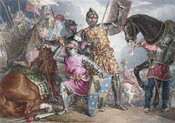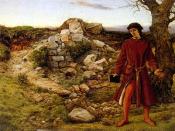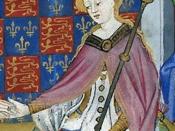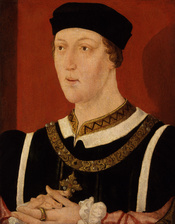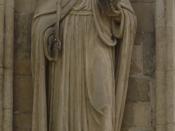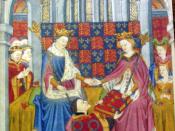In a scholarly journal article authored by Robert Y. Turner the writer notes that "the major figures in [William Shakespeare's] Henry VI undergo no moral change of character" (241). In the series of plays these major figures, all of whom are nobilities, serve as archetypal representatives of the disorder that disrupts the normal order of the noble society. In his article Turner refers to a host of characters possessing stagnant moralities and presents the idea that ethical stagnation in Shakespeare's history plays could only be eliminated if motive is differentiated from character (243). The corruption that exists amidst the bard's characters contrasts the implied honor of their positions in the royal court, however it is a direct reflection of the characters' moral fibers and the disorder of the normal order of the noble society.
An individual for whom analysis is deemed appropriate is the Duke of Suffolk. Let it be recalled that Suffolk is one of the conspirators responsible for the death of Humphrey, Duke of Gloucester. In order to adequately evaluate the static morality of the Duke of Suffolk the actions that place his morality in question must be examined. Now, all of Suffolk's actions are carried out in a spirit of manipulation, more specifically, the manipulation of Queen Margaret and King Henry VI. Eventually, the scheming of Suffolk escalates into the murder of the Duke of Gloucester. After the killing of Gloucester is carried out in Act III scene ii, part two of Henry VI, Suffolk gives the following response to the murderers: "Go, get you to my house;" he tells them. "I will reward you for this venturous deed." This quotation serves as an excellent tool to delve into the mindset of Suffolk. It is clear from Suffolk's reaction to the successful carrying out of Gloucester's murder that he is a ruthless man. Employing the hands of hit men to commit murder surely brings the Duke of Suffolk's morality into question. Suffolk never shows remorse for his actions, not even before his own death, thus his tainted moral standards remain true to form.
Margaret, the Queen of England, is another key figure in the second part of Henry the Sixth that demands examination. Unbeknownst to her, she is a tool being manipulated by the clever ruses of Suffolk, but she also has some schemes of her own. In Queen Margaret, Shakespeare develops a character who is pitiless and cruel, a character who is determined to seize and exercise power (Lee 183). Her husband, the King, is a weak ruler, perhaps better suited for a position as a clergyman. Conversely, she is strong-willed and thirsty for the monarchal power held by the King, but she is also a woman. The aforementioned qualities assigned to Queen Margaret are not typical qualities of a woman of the period, thus "Margaret and Henry represent the reversal of the natural order of male/female and husband/wife as well as subject/sovereign relationships" (Lee 217). This is not only true of their internal qualities, but also of their external actions. As King Henry's ineptitude to adequately rule his kingdom grows, so does the authority of Queen Margaret. Figuratively speaking, Margaret wears the pants in the relationship. This essentially enables her to assume the role of her husband, yet this role assumption can be maintained only as long as Henry wears the title, "King of England." When King Henry meets his death at the hands of Richard in part three of King Henry VI, Margaret must inevitably forfeit her reign, but during her tenure in power she manages to embody the aggressiveness expected of a male ruler, despite her sex being otherwise, as she raises armies to fight and even inflicts death on another with her own hands. Accordingly, in Act I scene iv of the third part of King Henry Sixth, the Duke of York refers to Margaret as having a "tiger's heart wrapt in a woman's hide!"Richard, a character who appears in part three of Shakespeare's King Henry VI and in Richard III, is yet another key figure, and perhaps the most vile example of a character who exemplifies a stagnation of moral uprightness. Like Margaret, Richard is teeming with monarchal ambition and will stop at absolutely nothing to ascend the throne that he feels has unjustly been taken from his family, the House of York, and consequently him. Moreover, Richard is a character who suffers from physical abnormalities. Shakespeare plays upon these bodily oddities often, for they correlate to other elements of Richard's characterization. Many scholars draw parallels of Richard's physical disfigurement to the viciousness of his evilly ambitious nature. Maurice Hunt suggests that Richard is not polluted with "ruthless ambition" and that the "motivation for his cruelty arises from his bitter desire to deface, to disorder the beautiful handiwork of the God who has malformed him" (11). Richard exhibits the cunning of a fox in his ability to mask the malevolence that fills him to the core from those people who he plans to slay (Colley 452). Richard's path to the throne and the designation, Richard III, King of England, is one that is imbrued with the blood of many, but spilled blood is of no concern to the villain. His focus on attaining kingship is absent of any plan of integrity.
The absence of moral growth is a common theme among the cases presented on the characters Duke of Suffolk, Queen Margaret, and Richard III. Each of these individuals contribute to the disorder and corruption of the world that is presented in the narratives. Now, it is common knowledge that every state of affairs is a matter of cause and effect. The normal order of society portrayed is disrupted (effect) because each of the key figures act on their feelings of discontent (cause) about their ranks in that order. All other things constant, the normal order of the society can be restored, but this requires that the characters substitute their disgruntled reactions with actions that do not involve altering their ranks, for their current ranks must remain unchanged to preserve the normal order. Although the general idea that represents the cause of disruption is the same for all three characters, their individual behaviors vary and each of these variants can offer insight about the characters. Much can be learned from analyses of their individual courses of progression through the narratives.
It is previously stated that the Duke of Suffolk is a man of manipulation. The most prominent of his exploits is his use of Margaret and King Henry. Margaret is a Frenchwoman who was captured by Suffolk during the French Wars. He develops an interest in her, for he finds her to be a woman of abundant beauty. However, Suffolk is already a married man, so he woos Margaret for King Henry. Next, Suffolk convinces the King to wed Margaret and make her the Queen of England. Suffolk knows that King Henry's strength of rule is feeble at best, but Margaret is not aware of this. The Duke of Suffolk and Margaret soon develop an affair and with each passing day Margaret becomes more cognizant of and more dissatisfied with her husband's weakness. Suffolk now has control of King Edward through Queen Margaret and is able to manipulate his hold over the King to his own liking. This is the manifestation of the ploy hat Suffolk has been crafting all along. Through a reversion to part one of Henry VI proof can be found that this was his intention as he quotes, Margaret shall now be Queen, and rule the King; / But I will rule both her, the King, and realm" (V.v). Unfortunately for Suffolk, his manipulative efforts backfire when the commoners request that he be exiled for the wrongful death of Gloucester, a wish that is satisfied by the King. Even though Suffolk's efforts do not end in his favor, they initiate disorder. There is now a queen in place whose ambition will further agitate the natural order of the noble society, but Margaret would never have been the Queen of England if Suffolk had not acted on his motives of ascension, thus, the turmoil that ensues is directly related to Suffolk disrupting the normal order by trying to lift his status.
Margaret, the Queen of England, has some characteristics that are more befitting of a man than of a woman. At the forefront of these characteristics is ambition. When Margaret is presented to King Henry for marriage she has no money and nothing to offer, but the beauty of her physical self and of her speech are so undeniable that King Henry moves forward with the marriage. It is not long before Queen Margaret wants more from her union with Henry. When this displeasure begins to sink in Margaret proceeds to embark on a quest for a change. This ambition-driven quest is fuel to the fire that is disorder in the natural order of the given society. Her hunger to retain and obtain power leads her to wage battles against opposing forces. These battles serve as thematic symbols and are representative of the overall corruption that runs ramped through the English Monarchy.
Of the three key figures discussed, Richard is the most ambitiously mad. His aspirations are greater than those of Suffolk and Margaret, so it is only fitting that he triggers the most disorder of the three major characters analyzed. Richard wants more than to just merely increase his rank in society. He wants to obtain the throne and will do so with an "anything goes" attitude. The House of York is in a struggle with the house of Lancaster to reclaim the throne that they feel has been usurped from their branch of the family. In part three of Henry VI this struggle reaches resolve when the Yorkists' overthrow the House of Lancaster and Edward, the eldest surviving male heir in the House of York, seizes the throne to become King Edward IV. Yet, the succession of rule belonging to the House of York is not enough for Richard. His thirst to be King of England is so potent that he arranges for the murder of one of his older brothers such to omit him from the line of succession. Richard has an incredibly twisted mind and he relentlessly plots his acquisition of the English kingship. Even more fascinating than his overt evil is the veiled evil that makes its home in Richard's deformities. Richard is able to use his physical abnormalities to gain the sympathy of those around him which makes victims less suspecting of his evil. This idea conflicts with the suggestion presented previously by Maurice Hunt, documented in paragraph four of this commentary.
One element that is shared by all of William Shakespeare's plays is that of disorder. In the cases of the Duke of Suffolk, Queen Margaret, and Richard III, this disorder branches from two types of conflict. The first type of conflict is man versus man. All three of the key figures disrupt the normal order of the society of nobles after they are unable to successfully resolve their own internal conflicts. It is the failures to settle the battles within the hearts, minds, and souls of the characters that ultimately lead them to attempt self appraisals. The existence of internal conflicts prevent the characters from conducting their self appraisals from the inside out, for they do not find inner peace as valuable as power over others. If the moral character of these physical characters makes no growth, then there can be no positive resolution of conflict and as a result disorder will be a mainstay in the community portrayed in the narratives.
The second type of conflict from which disorder branches is man versus man. Suffolk, Margaret, and Richard fail to make peace with themselves, thus it would be ignorant to assume that they will make peace with others. The characters' self-absorptions blind them from all things except for their personal desires. As a result, anyone who stands between our key figures and their personal desires becomes opposition. The more the characters selfishly pursue foes, the longer the disorder continues to live. Conflict is the face-off of two opposing forces and opposing forces will exist as long as personal gratification is paramount without regard to others.
Suffolk, Margaret, and Richard are all lacking moral character. This character flaw sets the stage for a seeming less endless barrage of chaotic happenings. It can be inferred that the only way to truly reach an optimistic halt to disorder is to make moral growth. It can also be inferred that acting on feelings of discontent disrupts the natural order of how things should be. However, if first, internal battles are conquered and peace is obtained from within, then corruption will find itself halted. If there is corruption within a person there will be corruption in that person's environment. Likewise, if a person knows inner peace they will also know outer peace.
Works CitedCandido, Joseph. "Getting Loose in the Henry VI Plays." Shakespeare Quarterly 35 (1984): 392-406.
Colley, Scott. "Richard III and Herrod." Shakespeare Quarterly 37 (1986): 451-458.
Hunt, Maurice. "Ordering Disorder in Richard the III." South Central Review 6 (1989): 11-29.
Lee, Patricia A. "Reflections of Power: Margaret of Anjou and the Dark Side of Queenship." Ed. Margaret L. King, Bridget G. Lyons, Colin Eisler, Wallace T. Maccaffrey, and James V. Mirollo. Renaissance Quartlerly 39 (1986): 183-217.
Shakespeare, William. "King Richard the Third." William Shakespeare: the Complete Works. Comp. Arthur H. Bullen. New York: Barnes & Noble, Inc., 2005. 98-138.
Shakespeare, William. "The First Part of King Henry the Sixth." William Shakespeare: the Complete Works. Comp. Arthur H. Bullen. New York: Barnes & Noble, Inc., 2005. 1-30.
Shakespeare, William. "The Second Part of King Henry the Sixth." William Shakespeare: the Complete Works. Comp. Arthur H. Bullen. New York: Barnes & Noble, Inc., 2005. 31-64.
Shakespeare, William. "The Third Part of King Henry the Sixth." William Shakespeare: the Complete Works. Comp. Arthur H. Bullen. New York: Barnes & Noble, Inc., 2005. 65-97.
Turner, Robert Y. "Characterization in Shakespeare's Early History Plays." ELH 31 (1964): 241-258.
Williams, Gwyn. "Suffolk and Margaret: a Study of Some Sections of Shakespeare's Henry VI." Shakespeare Quarterly 25 (1974): 310-322.
